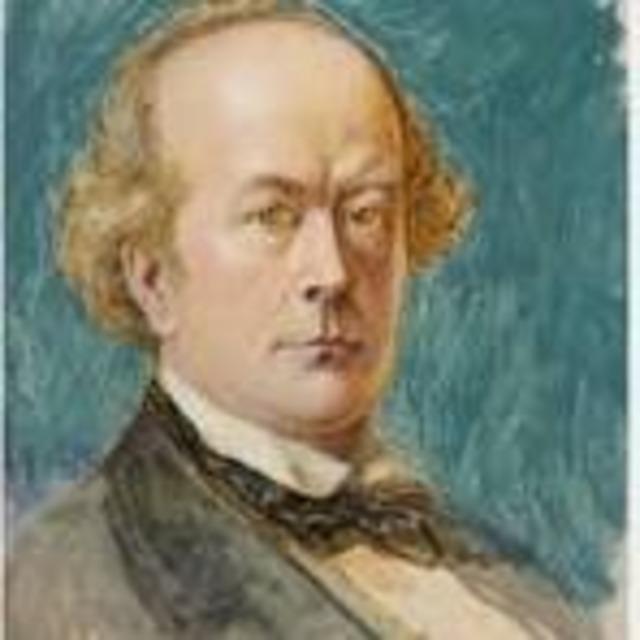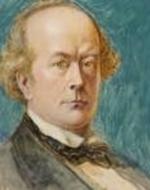Created by Lydia Walker on Tue, 03/19/2024 - 12:27
Description:
Richard Doyle (1824-83), also nicknamed "Dicky" Doyle, had an exceptional talent for illustrating Victorian social issues while also bringing life to fantasies and fairytales. He made his first publication, The Tournament, at age 16, which acted as a showcase of his talent as a blossoming artist. The Tournament is a comic series on ten envelopes, mocking the Eglinton Tournament. The Tournament catalyzed his career as a satirical illustrator on social commentary. From there, Doyle went on to work for Punch magazine from 1843-50. After five professional artists failed to please Mark Lemon, the editor of Punch, Lemon commissioned Doyle, an amateur illustrator, to design a cover for the periodical. Doyle's design became a smashing success. His drawing appeared on the cover of Punch from 1849-1956 and marked the beginning of Doyle's fame as a satirist and caricaturist. It also introduced his ability to draw whimsical characters, such as goblins, jesters, and creatures with large noses. After working for Punch, Doyle became a freelance designer, illustrating children’s books such as The Enchanted Doll (1849) and The King of the Golden River (1851), for which Doyle most notably drew the "Frontispiece" as well as the rest of the illustrations.
By the sixties, Doyle dedicated his time equally to designing satirical pieces and children's book illustrations, specifically those entailing fantastical characters, such as the Southwest Wind. Although fabricated characters may seem whimsical and innocent at first sight, Doyle used the characters to warn individuals about the flaws of human nature. He often designed fairies to symbolize the suppressed unconscious and the resulting disturbed mental states that may arise in dreams; jesters and clowns represent the fun of a carefree life but the danger in trusting jokers; and the Southwest Wind represents the result of selfishness. Similarly, in Doyle’s satirical pieces, he commented on political issues, such as slavery, the cholera outbreak, and the wealth disparity between the rich and poor, emphasized in his first accomplishment, The Tournament.
Henry Richard Doyle, Portrait of Richard Doyle, n.d., oil on canvas, National Gallery of Ireland, Wikipedia. Richard Doyle was the son of John Doyle, an Irish satirical political cartoonist. John enjoyed the detailed work of portraitism, especially of political figures, so he could emphasize and mock their imperfections. John's satirical style inspired Richard to begin his career as a political cartoonist. Henry Doyle was Richard's younger brother by thirteen years and specialized in portraitism and cartoons like John. He initially illustrated for Punch, where Richard was making his name, but Henry Doyle considered Punch beneath his abilities and went on to become a cartoonist for Fun magazine. Regardless of their differing professional goals, Richard and Henry both shared a love of mockery in their illustrations, inspired by their father. A bit of playful mockery seems evident in Henry's portrait of Richard, where his forehead protrudes and is accentuated by the gleaming light on his bald head with his eyes drawn close together.
Richard Doyle, Plate 5, from his The Tournament, 1840, lithographic print on stone, London, The Victorian Web. The Tournament's mockery of the British aristocracy began Doyle's satirical commentary on social issues. Lord Eglinton poured an absurd amount of money into the Eglinton Tournament in 1839, a reenactment of an idealized version of the Medieval period. It became an excuse for the wealthy to dress in lavish armor suits and reenact jousts with expensive weapons. Doyle emphasized the Tournament's preposterousness in his plates, particularly Plate 5, to demonstrate how the aristocracy wasted money on a trivial event when it could have been used to help the poor meet their physiological needs. In plate 5, he depicts a knight flying off the back of a horse, whom he is unable to control. The horse is running away, completely ignoring the shouting knights. One of the reenactors appears shocked, holding out his arms helplessly to catch the knight, whom the viewers know will inevitably fall. The other knights also appear helplessly surprised. Doyle portrays all of the aristocrats completely incompetent in their reenactment of a medieval joust, accentuated by their facial expressions.This incompetency contrasts their usual social and economic prestige, creating an air of satirical humor.
Richard Doyle, The Cover of Punch Magazine, from Punch, 1859, The Victorian Web. Doyle's satirical yet jovial style, inspired by his father, blossomed during his time working at Punch from 1842-1850. Mark Lemon asked Doyle to design the cover in 1843 after five artists before failed to please him. Doyle's comical ridicule of contemporary art and light-hearted commentary on sexual politics made his cover successful for over a century. He mocks the 1830s and 40s' obsession with classicism, a style held in high regard during the Victorian era and inspired by Greek and Roman art that was notable for disguising erotic themes with aesthetic nudes. Doyle mocks the art’s hypocrisy by drawing the figure of Punch on a donkey, supporting a pole above his head, which could also be mistaken as genitalia. This crude, but amusing humor helped contribute to the jovial themes that softened the danger in offending the public. Doyle draws Punch glancing sideways at the audience as if telling us to keep a secret. The jesters and clowns emulate the ones in Shakespeare's The Tempest, who make audiences laugh but also cause trouble. However, Doyle also creates a sense of homeliness by drawing Punch sitting in his chair, as if by a fireside about to read the journal with Toby the dog sitting next to him. Overall, Doyle's seemingly jolly drawings mixed with satirical undertones allowed audiences to notice new, impactful details on Punch's cover every time they viewed it.
Richard Doyle, Frontispiece, from The King of the Golden River, by John Ruskin, 1851, London, The Victorian Web. The “Frontispiece” portrays the Southwest Wind disguised as an old man, knocking on the three brothers' door in search of sympathy and shelter. Doyle aims to capture the Southwest Wind's absurd but unalarming stature. He appears four feet, six inches in height, with chubby, rosy cheeks, spindly limbs on his round torso, and wearing a tall, pointed hat nearly as tall as him. Doyle understands viewers will judge the Southwest WInd by his appearance, which will make his surge of strength even more shocking. After Gluck allows the little old man into the house and gives him dinner, his two brothers, Hans and Schwartz, become enraged that Gluck gives their food away, despite their great wealth. Their act of selfishness provoks the Southwest Wind to create a storm, ruining the entire valley and inhibiting anymore rainfall, causing a prolonged drought. Doyle depicts the message to not judge one's character by their appearance. He captures the Southwest Wind's unexpected power--which shocks Hans and Schwartz--by illustrating his small stature and spindly limbs.
Richard Doyle, "A Rehearsal in Fairyland," from In Fairyland, by Hans Fischer, 1870, London, The Victorian Web. The Victorian era used fairy art as a means to escape the harsh realities of 19th-century Britian and partake in a more fanciful land. Doyle used fairies as symbols of escapism from scientific discoveries into a magical world. In A Rehearsal, the sweet, colorful birds surrounding the little fairy, who appears as a little girl, mimics the innocent pleasures of childhood. Doyle brings adults down to eye-level with the birds and fairy in the grass, allowing them to reenter the nostalgia of the days when one's only worry was a chorus rehearsal. The vibrant oranges and blues of the birds create a group of unique birds uniting in a beautiful collaboration. The forest atmosphere creates an element of uncertainty in the surrounding area, adding to the mysteriousness of fairies.
Works Cited:
Cooke, Simon. "Richard Doyle and the Conventions of Fairy Art." The Victorian Web (2021). electronic.
Cooke, Simon. "Richard Doyle and the Eglinton Tournament." The Victorian Web (2023). electronic.
Cooke, Simon. "Richard Doyle and the front cover of Punch." The Victorian Web (2015). electronic.
Cooke, Simon. "The Doyles; A Talented Victorian Family of Artists and Writers." The Victorian Web (2023). electronic.






